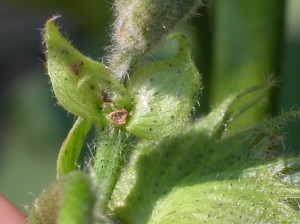So far I would have to say we’ve started out normally with tarnished plant bugs in cotton. There are treatment level plant bug populations present in some but not all fields. There have been reports of clouded plant bugs in the mix, and I have seen the same in Jackson.
Reminders
- Beginning the third week of squaring, the threshold increases to 15 plant bugs per 100 sweeps.
- Monitoring square retention prior to bloom is an important component of managing plant bugs. You should be more aggressive than the above thresholds if square retention drops below 80%.
Treatment Options
- The normal treatment options prior to flowering are the neonicotinoid insecticides such as Centric 40WG or one of the imidacloprid products.
- The minimum recommended rate for Centric is 1.5 oz/acre, and higher in high pressure situations. I also suggest bumping the rates as the cotton gets bigger. Centric at 1.75 – 2.0 oz per acre is my preferred treatment when battling heavy infestations of plant bugs prior to flowering.
- Use full labeled rates of imidacloprid and remember to use the correct rate for the product you select. There are 1.6, 2, 4 and 4.6 lb formulations available.
- Belay (3 – 4 oz/acre), Carbine 50WG (2.6 – 2.8 oz/acre) and Intruder 70WSP (1.1 oz/acre) are other options. I typically only recommend Intruder in cases where aphids are the primary target and some plant bugs are present (not the other way around).
- What about Diamond? This product is being promoted as a third week of squaring spray in high pressure areas in the central and lower Mississippi River Delta. I prefer it as an option for the first plant bug spray once cotton has begun to bloom. This better matches our typical infestation patterns in Tennessee. The best fit for Diamond will be in historically high pressure areas and perhaps for fields heavily bordered by corn. Spraying the third week of squaring may be appropriate when a lot of adults migration is being observed. Keep in mind that this product does not kill adults, but it can have good downstream impact on immatures when timed correctly. The typical use rate of Diamond is 6 oz/acre, and some folks will cut it back to 4 oz if tank mixing with an adulticide.
I’ve had a number of questions about adding a “knockdown” component to plant bug sprays. OP (acephate, dimethoate, Lorsban, etc.) and pyrethroid insecticides are not generally suggested prior to flowering, in part for resistance management but also to prevent the flaring of spider mites or aphids. The goal is to preserve the activity of OP and pyrethroid insecticides for use later in the season. Adding a tank mix will not substantially extend residual control or improve knockdown unless you are using less than recommended rates. Some of this “improving knockdown” jargon comes from the days when we used cut rates of imidacloprid, which frankly, were not adequate. Also, believe it or not, finding plant bugs several days after treatment is very possible as new adults migrate into the field. This may give the impression of poor “knockdown” that is not reality.


